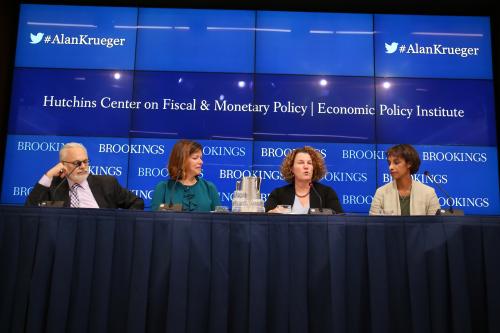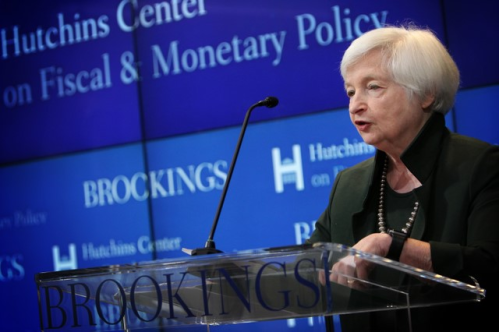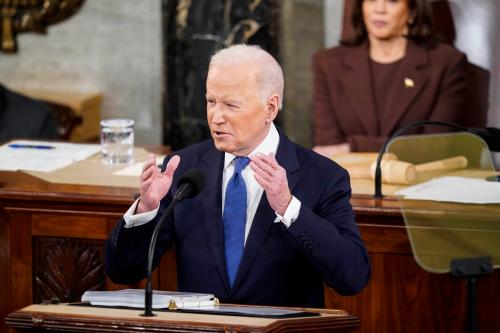A growing chorus has called on the Fed to diversify its ranks at all levels to reflect better the heterogeneity of the United States. So far most of these efforts speak to the diversity of the Fed’s principals, namely, the members of the Fed’s Board of Governors and the presidents of the twelve Federal Reserve Banks. In this study, we dig deeply into a vital part of Federal Reserve governance that has so far not received the same sustained attention: the directors of the Federal Reserve Banks, those responsible for choosing the presidents of the Federal Reserve Banks in the first instance. We find a staggering homogeneity among them, with only recent signs of diversification. They are overwhelmingly white, overwhelmingly male, and overwhelmingly drawn from the business communities within their districts, with little participation from minorities, women, or from areas of the economy—labor, nonprofits, the academy—with important contributions to make to Fed governance. We conclude by recommending that the Federal Reserve System—the Board of Governors, the Federal Reserve Banks, and the member banks that belong to the system and vote for some of these directors—make their selection processes more transparent for outside evaluation such that progress (or lack thereof) can be better measured and attributed.
Introduction
The Federal Reserve System, the collection of institutions that form the central bank for the United States, has a diversity problem. This has long been obvious at the top of the organization, among the members of the Fed’s Board of Governors and the presidents of the Federal Reserve Banks (who constitute, together, the Federal Open Market Committee, the group that decides the nation’s monetary policy).1 These key economic policymakers, among the most important in the nation, are overwhelmingly white and male. There have only been three Black members of the Fed’s Board of Governors, only one Black Federal Reserve Bank President, and only three nonwhite Federal Reserve Bank presidents in the entire system’s history. There is also a sense that these principals are overwhelmingly promoted from within, creating a risk for groupthink and intellectual homogeneity.2
This homogeneity runs deep within the Federal Reserve System, including at the staff level.3 Less attention, however, has been paid to another extraordinarily important part of the Federal Reserve System: the directors of the twelve Federal Reserve Banks. Since the Fed’s inception in 1913, the directors were designed to be private-sector gatekeepers for the Fed’s extraordinary power, as a compromise between public and private influence over the regulation of the nation’s money. The Federal Reserve Act makes the diversity of those directors clear: these directors are to “represent the public . . . elected without discrimination on the basis of race, creed, color, sex, or national origin, and with due but not exclusive consideration to the interests of agriculture, commerce, industry, services, labor, and consumers.”4
This provision, added in large part in 1977, is intended to rectify historical exclusions on a grand scale. This report provides something of a report card on that effort. Using the 106 publicly available annual reports of the Board of Governors from 1914 through 2019, we compiled a database of all individuals who have served as Federal Reserve Bank directors. Beyond the basic information found in the annual reports, we expanded the biographical database to include race, gender, profession, education, age, time spent in position, and whether or not the directors later held a position on the FOMC.
This biographical database significantly expands, in time horizon and scope of diversity measures, two important and invaluable studies done in the last decade. First, the Wall Street Reform and Consumer Protection Act of 2010 (“Dodd-Frank”), the financial regulation reform legislation passed in response to the financial crisis of 2008, included a provision requiring the Government Accountability Office conduct a review of the governance of the Federal Reserve Banks.5 Their report, published in October 2011, covered race, gender, education, and industry of directors between 2006 and 2011. Based on the report’s review, the GAO issued several recommendations aimed at “enhancing the diversity of the Reserve Bank boards, strengthening policies for managing conflicts of interest, and enhancing transparency related to board governance.” The second study, conducted jointly by Fed Up and the Center for Popular Democracy, covered race, gender, and industry between 2013 and 2019, concluding that “the Fed’s pace of change is entirely too slow.”6 Both made significant contributions to the public dialogue around diversity at the Fed and included recommendations that the Fed broaden recruitment of directors and increase transparency of the selection process and governing documents of the directors.
Our database expands the timeline of the above-mentioned databases back to the very founding of the Fed and broadens the scope of diversity measures. This allows us to explore in this report, for the first time, the full breadth and history of diversity in this critical leadership role at the Fed.
The results are not good. On race, we see that the first nonwhite directors were not appointed by the Board of Governors until the 1970s. Even as late as the 2010s, nonwhite directors represented less than 10% of the total directors in any given year. Representation of female directors tracks a similar, though slightly less dire, pattern, with the first females also appointed in the 1970s, reaching 10% by the late 1990s, and increasing more quickly in the 2010s to 37% in 2019.
Sectoral representation also suggests important trends that have not been fully understood or analyzed. First, directors from manufacturing backgrounds decreased as a share of directors overall since the 1940s. Second, there is a substantial increase in the portion of directors from the nonbank financial sector since the 1980s. These are directors who are explicitly meant to represent sectors besides finance.
Third, and perhaps most surprising, only 5 percent of directors have a PhD in economics—inarguably an important credential for their main task of evaluating the competence of central bankers—since 1970, when the first Fed Chair with a PhD was appointed. In general, economists are arguably overrepresented at the Fed’s senior ranks, but at the level of Fed directors, they are underrepresented, potentially so much so that their central governance purpose becomes much harder in evaluating candidates.
Given the failures by many measures of diversity, some have argued for much more transparency in the selection process for Federal Reserve Bank presidents.7 We agree. More specifically, we urge the Fed—and, where necessary, Congress—to develop and disclose a more detailed framework through which Federal Reserve Bank directors are selected. This proposal is not simply an argument in favor of transparency for transparency’s sake, but a recognition that diversification of candidate pools and appointments requires substantial effort and strategic thinking. This transparency will allow outsiders to participate in those efforts and evaluate the results—to credit the Fed’s successes and exercise accountability for the failures.
The report is organized as follows. Part I provides background on the Fed’s governance and the changes that Congress and the Fed itself have made over the years to increase director diversity. Part II, the bulk of the report, presents and describes the data we have collected to describe the path of diversity at the Federal Reserve. In particular, we focus on four elements of that diversity from the database: race, gender, occupation, and education. The first two have received most of the attention in recent discussions; the last two much less so. Part III concludes with a more fully developed program for reform. Two appendices available for download present more data on race and gender, disaggregated by Federal Reserve Bank.
I. The Governance of the Federal Reserve
The Federal Reserve System is a governance curiosity. The “federal” in its name is something of a misnomer. There is no state-national balance in the system, but instead a balance between Fed regions—twelve Federal Reserve Districts that were designed at inception largely by Democratic politicians in a somewhat partisan exercise that often bisected specific states—and the Washington-based Federal Reserve Board.8 The Board was initially chaired by the Secretary of the Treasury and included other presidential appointments that required Senate confirmation, for political accountability purposes. The Reserve Banks, one for each Federal Reserve District, would have a President (earlier styled a “Governor”), appointed by its directors. Congress divided those directors into three classes: Class A directors would be “chosen by and be representative of the stock-holding banks,” those banks that joined the Federal Reserve System. Class B directors would be “actively engaged in their district in commerce, agriculture, or some other industrial pursuit,” and would be elected by stock-holding banks in the same manner as Class A directors. And, finally, Class C directors would be “designated by the Federal Reserve Board,” at least two of whom would be individuals of “tested banking experience,” but could not be an employee of a stockholder bank.9 The purpose of this intricate arrangement was in the spirit of checks and balances: the public needed a Federal Reserve Board for political accountability, but also the private Federal Reserve Banks to ensure that that accountability did not turn the enterprise into a purely partisan one.
In 1935, the Federal Reserve System was reorganized into the modern version with a Board of Governors in Washington, DC and a Federal Open Market Committee that consists of both Fed Governors and Reserve Bank Presidents. The structure of the Reserve Bank directors remained the same.
Congress has updated this somewhat byzantine governance framework with respect to Fed directors at various important points during the Fed’s century. Two changes are especially important. First, in 1977, Congress updated Section 4 to include an anti-discrimination provision for each class of directors. These directors would thenceforth be selected “without discrimination on the basis of race, creed, color, sex, or national origin.”10 The Class B and C directors were to “represent the public” and would also be selected “with due but not exclusive consideration to the interests of agriculture, commerce, industry, services, labor, and consumers.” As in 1913, the banks would elect both Class A and Class B directors and the Board of Governors would appoint the Class C directors.
The other major change, one of director responsibility rather than director selection, came in 2010 as part of Dodd-Frank. After 2010, the president and first vice president of the Federal Reserve Banks would no longer be selected by vote of the full board of directors, but “shall be appointed by the Class B and Class C directors of the bank [the nonbanker directors], with the approval of the Board of Governors.” The role of the Class A directors, the bankers, in participating in the presidential search remains uncertain but not legally forbidden.
Beyond these statutory parameters, the other formal law governing the appointments process for Federal Reserve directors is about the voting process. There is little formal law governing who can be appointed, although the Fed does publish a document outlining the “roles and responsibilities of Federal Reserve Directors” that adds some gloss to the statute.11
Most importantly, there is no mechanism to ensure diversity along any parameter beyond a prohibition against discrimination (with no enforcement or information-gathering mechanism) and the relatively weak endorsement of “due but not exclusive consideration” for various constituencies beyond banking.
II. Evaluating the Fed’s Diversity
In June 2020, during a regular FOMC press conference, Fed Chair Jay Powell confronted the problems of racism and the opportunities for diversity directly. “I speak for my colleagues throughout the Federal Reserve System when I say that there is no place at the Federal Reserve for racism.” He added: “These principles [of non-discrimination] guide us in all we do, from monetary policy, to our focus on diversity and inclusion in our workplace, and to our work to ensure fair access to credit across the country.”12
Powell and his colleagues have continued to emphasize these issues, including within the Federal Reserve System itself. Shortly before the following FOMC press conference, a former Board staff economist published a blistering public letter that demonstrated poor diversity performance in the economics field broadly and at the Fed specifically.13 When asked about the letter, Powell further acknowledged, “there’s been a lot of pain and injustice and unfair treatment that women have experienced in the workplace – not just among economists, but among economists at the Fed…the Fed could have done more and should have done more.”14
Powell isn’t the lone voice from within the Fed calling for the institution to do better. Federal Reserve Bank of San Francisco President Mary Daly spoke movingly and personally about the gender discrimination she faced as a junior employee of the Federal Reserve System.15 Raphael Bostic, President of the Federal Reserve Bank of Atlanta, the first—and as of 2021, only—Black Fed president, has given three speeches in the last six months focusing on the importance of diversity at the Fed and in the broader economy.16 Scholars have also started focusing more on failures of diversity within the financial regulatory community, including important studies published by Brookings by Aaron Klein, Chris Brummer, and David Wessel.17
Methodology
As important as these conversations are, key mechanisms for improving diversity within the System remains in the hands of these Reserve Bank directors. To understand better the problem that Powell, Daly, Bostic, and many others have identified, we take a long view to outline just how grave the problem is that the Fed is confronting.
Using the 106 publicly-available annual reports of the Board of Governors from 1914 through 2019, we compiled a database of all 2,607 individuals who have served in unique positions as Federal Reserve Bank directors.18 The information on the annual reports include only district, city/state, employer, and board leadership position. From board position we were able to garner two pieces of information.
Beyond the information available on the annual reports, we expanded the biographical database to include: race, gender, profession, education, age, time spent in position, and whether or not the directors later held a position on the FOMC. With help from a team of exceptional research assistants from the University of Pennsylvania and elsewhere, we reviewed historical materials to catalogue this additional biographical information. Our primary sources include: newspaper archives, census records, genealogical databases, and corporate profiles.
We were able to find information on the diversity measures listed above for the following proportions of directors in the database: a white/nonwhite race indicator for 97.5 percent of the directors, a male/female gender indicator for 100 percent of the directors, the sector of 100 percent of the directors, and the terminal degree for 72 percent of the directors.19
Dividing individuals into a binary white/nonwhite category is a challenging pursuit that oversimplifies reality, particularly within the Latino/Hispanic community.20 For this database, we prioritized information and sources as follows: (1) self-identification in a primary source, (2) identification in a secondary source, (3) national origin/heritage in primary or secondary sources (all Latin/Hispanic countries from the Western hemisphere counted as nonwhite), and (4) subjective determinations based on director photographs. The last and admittedly least objective category constituted less than 10 percent of the nonwhite directors we recorded.
We do not include political affiliation, another important measure of diversity, in our analysis. However, Caitlin Ainsley, a political scientist from the University of Washington, conducted a review of political campaign donations from the Reserve Bank directors between 1980 and 2015, cataloguing donations from 71 percent of the directors. Ainsley’s study suggests that along this important dimension there is substantial heterogeneity among the directors, a heterogeneity that is less apparent in the areas we assess.21 These results suggest that the challenges to diversify the directors, while very real, are not insurmountable; whatever process is currently in place yields variety at least along this one dimension, suggesting a path ahead along others, too.
Race
Figure 1 represents the entire history of the Federal Reserve System and records the number of nonwhite directors since its founding in 1913 through 2019.22
We do not observe a trend of inclusion of nonwhite directors until into the 1980s, and even then the inclusion of racially-diverse directors is mostly a function of the Class B and C directors, the nonbankers. Even more worrisome than the total number of nonwhite Class A directors is that this number, never large, has actually decreased recently.
This is consistent with the known lack of gender and racial diversity in the US banking industry more broadly. In February 2020, the US House Financial Services Committee published a review of diversity based on a survey of the 44 largest banks in the country.23 The report indicates that while diversity in the industry has increased at the entry- and mid-levels, executives and other senior leaders remain overwhelmingly white. It is thus credible that the Fed’s diversity problem for Class A directors remains closely tethered to the diversity problems for banking in general.
We can observe more differences when we break racial diversity by Federal Reserve Bank. Figure 2 represents the first year that each Federal Reserve Bank appointed its first non-white director, beginning in 1972 (Philadelphia and San Francisco) and ending in 1992 (Kansas City).

Appendix A goes further to break down the inclusion of nonwhite directors by each of the Federal Reserve Banks. The numbers are not promising: there are significant periods for each of the Federal Reserve Banks where there are not more than one or two nonwhite directors at a time. Only Chicago, Dallas, and San Francisco have had three or more nonwhite directors on any sustained basis. It appears suggestive at least that the 1977 law prohibiting discrimination had little effect in changing the racial composition of these boards.
Gender
The (lack of) gender diversity within the Fed’s boards of directors is a similar problem to that of race, as the first female directors are (1) nonbankers and (2) appointed in the 1970s, followed in the 1980s by the election of the first few female bankers. However, efforts to increase female representation has been far more successful than has been the case for racial diversity. Female directors represented 37 percent of all directors in 2019, across all Classes (though the numbers are still better for nonbankers). Figure 3 represents the Fed’s history with female directors across all districts.

Figure 4 represents the first year that female directors were appointed, from 1977 (Dallas, San Francisco, St. Louis, Atlanta, and Philadelphia) to 1988 (Cleveland).

Appendix B provides district-by-district analysis of female director participation. The Reserve Bank boards are, in general, not close to gender parity, with the important exceptions of the Federal Reserve Banks of St. Louis and Minneapolis who each had five female directors in 2019. Some districts remain far from parity; only two of the nine directors on each of the Chicago, Dallas, and San Francisco boards are female. Here, differently from the experience of racial diversity at the boards, our evidence is at least consistent with the view that the 1977 law had an impact—perhaps even a major impact—on the increase in gender diversity.
Similar to racial diversity, it is the case that finance in general has a problem, especially at the senior level, for gender parity. The Fed is not alone in this regard. What is remarkable here is that the Class B and C directors are explicitly not expected to be drawn from finance. Even so, for the most part the Fed struggles in this regard and has done so for most of its history.
Research by a Richmond Fed economist published in 2017 suggested that it would take over 30 years to reach gender parity for Reserve Bank directors at the current pace.24 Janet Yellen, current Treasury Secretary and former Fed Chair, explained why this matters at a September 2019 Brookings conference. She highlighted the basic fairness of increasing diversity, the better performance of diverse teams, and the “wasted talent” if institutions don’t increase diversity.25
Sectoral representation
We turn now to sectoral representativeness among the directors. Figure 5 illustrates the trends over time of the top 10 sectors.

Given that Class A directors are explicitly bankers elected by bankers, it is perhaps unsurprising to see their predominance. But a trend since roughly 1980 includes a substantial and growing number of non-banking finance representatives as the third-most represented single group, after banking and manufacturing. The influence of finance on the Reserve Banks’ governance remains very strong, even among the classes of directors meant to represent other interests.
Missing almost entirely from this equation, despite its inclusion in the list of statutory considerations, is labor. Figure 6 illustrates the absence of labor participation in Fed governance.

Figure 7 puts this data differently, outlining labor participation by each Federal Reserve Bank.

It is of course the case that organized labor is not the exclusive representative of working women and men, and never has been. Indeed, there is a long-term, well-documented secular decline in labor representation, especially in the private sector. The Bureau of Labor Statistics has tracked union membership in the US since 1980 and the percent of public sector union membership has only dipped from slightly above 35 percent to slightly below it. The decline in private sector union membership, on the other hand, has decreased steadily from nearly 17 percent in the 1980s to 6 percent last year.26
But even taking the general private sector decline in union membership into consideration, it is remarkable how minimal labor participation is in Federal Reserve governance, with few exceptions.27
Education
We have also investigated education attainment for the directors. Figure 8 tracks terminal degrees over time.

Note important gaps in our data—the further back we go, the less concrete the information. (Also, note that we use the JD degree as a substitute for the LLB, which did not become standard until the late 1960s.)
Notable here is the relative lack of participation on the boards of directors from academic economists, a reversal of a trend for the heads of the Reserve Banks themselves, where a majority of newly appointed Reserve Bank Presidents since the 1980s have had a PhD, 80 percent in Economics.28 The Reserve Bank boards of directors therefore may be the one place where economists are under-represented relative to their importance to Fed governance.
This lack of representation for economists poses something of a governance quandary for the Reserve Banks and their directors. If the directors’ primary responsibility is to select the presidents of their Banks, and the trend for central bankers is increasingly toward sophistication in graduate level economics, is it plausible for these directors—the overwhelming majority of whom do not have this training—to assess the merits of these candidates? We post the question but cannot answer it in this report. Suffice it to say that this mismatch raises more questions than this about the suitability of the present governance arrangements.
Figure 9 describes the area of academic focus for the directors.

These trends are consistent with the professionalization of private and public bureaucracy generally over the 20th century. Also, given the deep pockets of uncertainty, not much can be drawn about these differences on the basis of this data alone. They do invite further research, however, especially given, again, the relative dearth of economics as a field of study for these directors.
III. Implications and Reform
The foregoing data suggest four conclusions that are important to consider as the Fed seeks to diversify participation in the System.
First, the road ahead for diversifying along race and gender for the Reserve Bank directors will be challenging, if history is a guide. To be fair, this is not a problem for the Federal Reserve alone and nothing in this report supports that conclusion. We do not know how well or poorly other central banks, other government bureaucracies, or other private institutions have done on these same parameters.29 But if the goal is even representation—meaning, that the corps of Fed directors maps even passingly the population that these directors are meant to represent—then there is a long way to go.
Second, it is very difficult to believe that “due … consideration” has been given to labor in the selection of Class B and C directors, despite that statutory instruction. The participation of individuals with backgrounds in labor is a very small proportion of the entire corps of directors, and even then it is a recent phenomenon focused in some districts but not others. This failure is even more striking given the Fed’s recent prioritization of its full employment mandate over its inflation mandate.30Third, given the nature of the task for Reserve Bank directors—that is, the selection of central bankers who will make monetary policy—it is stark how little educational background in economics we observe, even in recent years where our data is more complete. Although economists are potentially over-represented in the highest reaches of the Fed (and in other central banks), they appear significantly under-represented as participants in Fed governance.
Fourth, director diversity is important for its own sake but also for the ways that that diversity will influence the roles that these directors play in shaping the agendas of the Reserve Banks, the Federal Open Market Committee, and even the general discourse around central banking in the United States and beyond. There are curiosities in the data, to be sure: the Federal Reserve Bank of Cleveland is the first Reserve Bank with a female president, the last with a female director. Diversity at the level of the directors will not solve diversity issues elsewhere in the System. But it will be an important start with lessons learned that will inform the processes throughout the System.
The Fed has already made public commitments to improving its challenges with diversity. We applaud those efforts. But to rectify a history as homogenous as this requires something more, especially given the byzantine governance structure and the limits that that structure imposes on centralized decision-making.
We therefore make the following three recommendations that, in order of ease of implementation.
- The Fed’s Board of Governors should make public the processes used to select Class C directors, including opening up that process for application and the publication of statistics regarding various aspects of such applications.
- The Federal Reserve Banks should, together, implement “best practices” for the selection of Class A and B directors such that the member banks that elect those directors can be guided by better processes.
- Congress should consider discarding as archaic the classified boards entirely and permit a more accountable mechanism for Fed governance that puts governance more squarely in the hands of political actors who can explain, defend, and answer for the successes and failures of those mechanisms.
Conclusion
The Federal Reserve System has never been the model of clear governance. But even short of a dramatic overhaul, it can become better. Indeed, just one year after he became the first Black Governor of the Federal Reserve in 1966, Andrew Brimmer commissioned an internal report on the Reserve Bank directors, concluding that the Fed “should have a better understanding of the characteristics of this group of public servants.”31 This is as true today as it was 55 years ago. Our report’s biographical database and the analysis we have conducted herein serves as an answer, a half-century later, to Brimmer’s charge.
If past is prologue, the future for Fed diversity at this important level is bleak. Fortunately, there is great hope that the past will in this case remain in the past. Directors in each class essentially all serve for a limit of six years. In relatively short order, then, each of the twelve Reserve Bank boards of directors can be remade. This means progress can be made quickly, if prioritized. It is our hope that the data and recommendations in this report will facilitate that transformation.
The authors did not receive financial support from any firm or person for this article or from any firm or person with a financial or political interest in this article. They are currently not an officer, director, or board member of any organization with an interest in this article.
-
Acknowledgements and disclosures
The authors are grateful to Aaron Klein for comments on an early draft. They are also grateful for the tremendous work of the following research assistants: Heather Nygaard, Matt Joachim, Heather No, Vishesh Patel, Richard Pletan, Jonathan Roth, and Lola Thrower.
-
Footnotes
- See Klein 2016, Saraiva et al 2020.
- See Klein 2015, Conti-Brown, Listokin, and Parrillo 2020.
- See Wessel et al.
- 12 USC 302.
- See GAO 2011.
- See Fed Up, CPD 2019.
- Fed Up 2019, Conti-Brown Mercatus, Nygaard Business Insider op ed., GAO report 2011.
- See Binder & Spindel 2017.
- Federal Reserve Act of 1913, H.R. 7837, Public Law No 43, December 23, 1913, section 4.
- 12 USC § 302.
- See here for the latest version.
- Press conference.
- See Claudia Sahm’s letter here.
- Press conference.
- See Daly 2018.
- See Bostic 2020a, 2020b, 2021.
- Klein, Brummer; Wessel.
- Annual reports are available on FRASER. Our database includes 1,957 unique people. For our analysis we used the 2,607 count which includes each time an individual served in multiple positions on the board of directors. For example, if an individual was first elected a Class B director and was later appointed the Board Chair (a Class C position) by the Board of Governors, we count this person twice. We believe this is a more appropriate count because it includes every time a new position on the board of directors was filled. Note too that this only includes directors who were in their position at the time the annual report was compiled. Therefore, some directors who started and ended their service between the compilation of two annual reports are not included in this analysis. Whitney M. Young, Jr., the first Black director, is one such individual not included in the database. See this NYT article reporting on his tragic death.
- Defined as the final degree they received, unless they received both a JD and PhD in which case both are catalogued.
- For a history of the terms Latino/Hispanic and their use in the U.S., see Martinez & Gonzalez (2020).
- See Ainsley 2020.
- Nygaard first discussed preliminary analysis of racial disparities among the directors of the Federal Reserve Banks via Twitter based on an early version of the biographical database here.
- Diversity and Inclusion: Holding America’s Largest Banks Accountable.
- See Gender Composition of the Boards of Directors of the Regional Federal Reserve Banks, by Arantxa Jarque and Caroline Davis, here.
- See Former Fed chair Janet Yellen on gender and racial diversity of the federal government’s economists, here.
- See the 2020 data release from the BLS here and historical charts of the BLS data compiled by USAFACTS here.
- Nygaard has advocated for the U.S. President and Senate to pay much more attention to labor representation at the Board of Governors, here. We both endorse this conclusion.
- Based on another biographical database created by Nygaard based off of FOMC participant biographies on the Fed’s history website.
- Though not within the scope of this paper, two resources worth mentioning here are: (1) a report by the OMFIF on gender diversity that includes analysis of gender in senior leadership at 156 central banks around the world, including the twelve Federal Reserve Banks reviewed separately; and (2) a Brookings report by Chris Brummer on the lack of diversity among US financial regulators.
- See Brookings’ Stephanie Aaronson for this broadly accepted interpretation of the Fed’s new Flexible Average Inflation Target.
- See the full report beginning on page 550 here.






